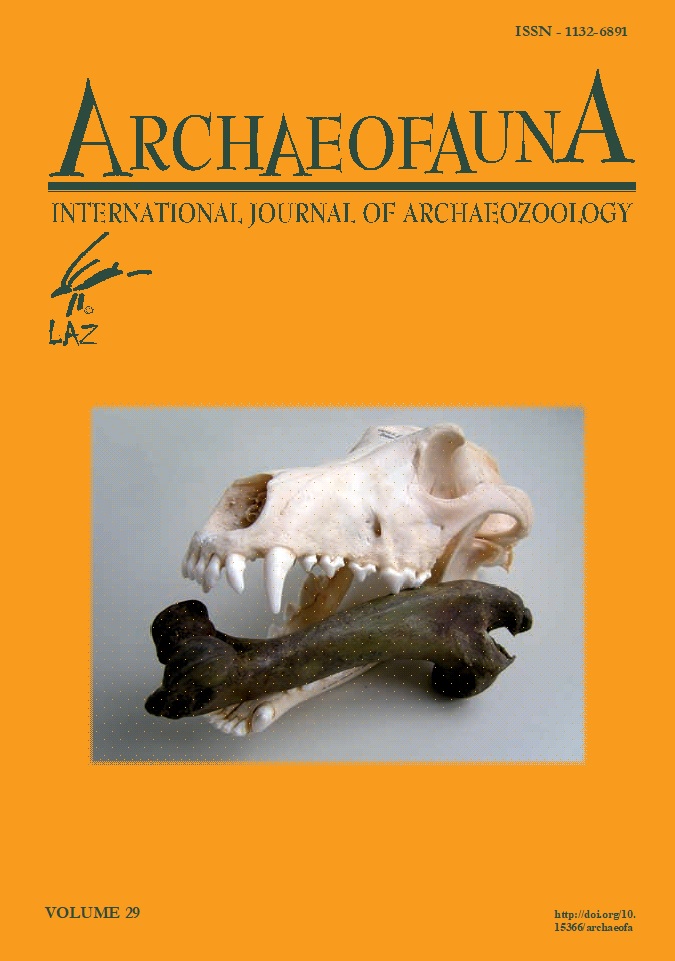Economía de los pueblos arios en el inicio de la Edad del hierro: Animales y hombres en el Asia Media pre-aqueménida
Palabras clave:
ARIOS, MEDOS, ARQUEOZOOLOGÍA, ASIA CENTRAL, EDAD DEL HIERROResumen
Los pueblos iranios, o arios como ellos mismos se llamaban, son los protagoni- stas indiscutibles del último milenio de historia del Antiguo Oriente. El cómo comenzaron a formar parte de la historia del Asia Central llegando a ser uno de los más fascinantes reinos de la Tardo-antigüedad son procesos que todavía hoy son difíciles de seguir. A lo largo de las sigui- entes líneas trataremos de recoger los trabajos de los investigadores soviéticos y de ponerlos en relación con aquellos que arqueólogos de diferentes países en colaboración con las repúblicas centroasiáticas están llevando a cabo en la actualidad, particularmente con nuestro trabajo en el marco de la Misión arqueológica española en Dahistán (suroeste de Turkmenistán) prestando siempre especial atención a la fauna que convivió con estos pueblos, tanto a través de la Arque- ología como de las fuentes escritas, todo ello enmarcado en la recientísima revisión de la historia del conocido como imperio medo.
Descargas
Citas
ARRIAN, L.F. 2001: Anábasis de Alejandro Magno (libros IV-VIII) (Übersetzung auf Spanisch von A. Guzmán Guerra). Madrid.
BLESA, J.L. 2013: Partakka-Parthava-Partia. Los reinos preaqueménidas de Asia Central en las fuentes escritas neoasirias (Unveröffentlichte Magisterarbeit an der UAM). Madrid.
BLESA, J.L. 2015: De jefes tribales esteparios a señores de las ciudades: las estructuras de poder entre los primeros pueblos arios. In: Del Cerro, C.; Milán, S. & Domínguez, A. J. (eds.): Actas de las V Jornadas de Investigación en Historia Antigua de la Universidad Autónoma de Madrid: Formas, manifestaciones y estructuras del poder en el mundo antiguo: 31-43. Madrid.
BOCHERENS, H.; MASHKOUR, M. & BILLIOU, D. 2000: Palaeoenviromental and Archaeological Implications of Isotopic Analyses (13C, 15N) from Neolithic to Present in Qazvin Plain (Iran). Enviromental Archaeology 5: 1-19. https://doi.org/10.1179/env.2000.5.1.1
BOCHERENS, H.; MASHKOUR, M.; DRUCKER, D.G.; MOUSSA, I. & BILLIOU, D. 2006: Stable Isotope Evidence for Palaeodiets in Southern Turkmenistan during Historical Period and Iron Age. Journal of Archaeological Science 33: 253-264. https://doi.org/10.1016/j.jas.2005.07.010
FUCHS, A. 1994: Die Inschrifien Sargons II aus Khorsabad (Doktorarbeit Universität Göttingen). Göttingen.
FUCHS, A. 1998: Die Annalen des Jahres 711 v. Chr. Helsinki. GRAYSON, A.K. 2002: Assyrian Rulers of the Early First Millennium BC II (858-745 BC). Toronto.
HALLOCK, R. 1969: Persepolis Fortification Tablets. Oriental Institute Publications 92, Chicago.
HAMSUN, K. 2007: La bendición de la tierra (Übersetzung auf Spanisch von K. Baggethun und A. Lorenzo). Barcelona.
HERODOT 1992: Historia (Übersetzung auf Spanisch von C. Schrader). Madrid.
HOJABRI, A.; DAVOUDI, H.; MOUSAVI, S.M. & MASHKOUR, M. 2017: Subsistence Economy During the Iron Age in Northwestern Iran: The Case Study of Tepe Hasanlu. The International Journal of Humanities 24/1: 30-48.
JOGLEKAR, P.P. 1998: A Preliminary Report on the Faunal Remains at Takhirbaj 1, Turkmenistan. In: Gubaev, A.; Koshelenko, G.A. & Tosi, M. (eds.): The Archaeological Map of the Murghab Delta. Preliminary Reports 1990-95. Reports and Memoirs, Series Minor 3: 115-118.
KUHRT, A. 2007: The Persian Empire: A Corpus of Sources of the Achaemenid Period. London.
LANFRANCHI, G.B. & PARPOLA, S. 1990: The Correspondence of Sargon II, Part II. Helsinki.
LEICHTY, E. 2011: The Royal Inscriptions of Esarhaddon, King of Assyria (680-669 BC). Winona Lake.
LEVINE, L.D. 1972: Two Neo-Assyrian Stelae from Iran. Toronto.
LHUILLIER, J. 2010: Le phénomène des «cultures à céramique modelée peinte» en Asie centrale dans l'évolution et la transformation des sociétés de la fin de l'âge du Bronze et du début de l'âge du Fer (IIe-Ier millénaire avant notre ère). Une synthèse comparative et régionale de la culture matérielle (Doktorarbeit an der Université Paris I Panthéon Sorbonne). Paris.
LHUILLIER, J. & MASHKOUR, M. 2017:Animal exploitation in the oases: an archaeozoological review of Iron Age sites in southern Central Asia. Antiquity 91: 655-673. https://doi.org/10.15184/aqy.2017.62
MASHKOUR, M. 1998: The Subsistence Economy in the Rural Community of Geoktchik depe in Southern Turkmenistan: Preliminary Results of the Faunal Analysis. In: Buitenhuis, H.; Bartosiewicz, L. & Choyke, A.M. (eds.): Archaeozoology of the Near East, III, Proceedings of the Third International Symposium on the Archaeozoology of Southwestern Asia and Adjacent Areas: 220-220. Groningen.
MASHKOUR, M. 2003: Equids in the Northern Part of the Iranian Central Plateau from the Neolithic to Iron Age: New Zoogeographic Evidence. In: Levine, M.; Renfrew, C. & Boyle, K. (eds.): Prehistoric Steppe Adaptation and the Horse: 129-138. Cambridge.
MASHKOUR, M. 2005: Animal Exploitation in the Lowland Pastures of Gilan (Iran) during the Iron Age. A Preliminary Archaeozoological Study of Jalaliye Kaluraz. In: Tadahiko, O.; Nokandeh, J. & Kazuya, Y. (eds.): Preliminary Report of the Iran-Japan Joint Archaeological Expedition to Gilan, Fourth Season: 96-108. Tehran-Tokyo.
MASHKOUR, M.; FONTUGNE, M. & HATTE, C. 1999: Investigations on the Evolution of Subsistence Economy in the Qazvin Plain (Iran) from the Neolithic to the Iron Age. Antiquity 73: 65-76. https://doi.org/10.1017/S0003598X00087846
NEZAMABADI, M.; MASHKOUR, M. & KARGAR, B. 2011: Mannaean Faunal Remains from Tepe Qalaichi, Northwestern Iran (9th?7th BC). Journal of Iranian Archaeology 2: 33-40. (Auf persisch)
POLYAENUS 1991: Poliorcética/Estratagemas (Übersetzung auf Spanisch von J. Vela Tejada und F. Martín García). Madrid.
QUINTUS CURTIUS RUFUS 1986: Historia de Alejandro Magno (Übersetzung auf Spanisch von F. Pejenaute Rubio) Madrid.
SALVINI, M. 2008: Corpus dei testi urartei. Rom. SHAHBAZI, A. S. 2013: Persepolis: Die altpersische Residenzstadt. Darmstadt/Mainz.
STARR, I. 1990: Queries to the Sungod. Helsinki. STRABON 2015: Geografía (libros XV-XVII) (Übersetzung auf Spanisch von J. L. García Alonso). Madrid.
TADMOR, H. & YAMADA, S. 2011: The Royal Inscriptions of Tiglath-pileser III (744-727 BC) and Shalmaneser V (726-722 BC). Winona Lake.
WU, X.; MILLER, N.F. & CRABTREE, P. 2015: Agro-pastoral strategies and food production on the Achaemenid frontier in Central Asia: a case study of Kyzyltepa in southern Uzbekistan. Iran 53: 93-117. https://doi.org/10.1080/05786967.2015.11834752

